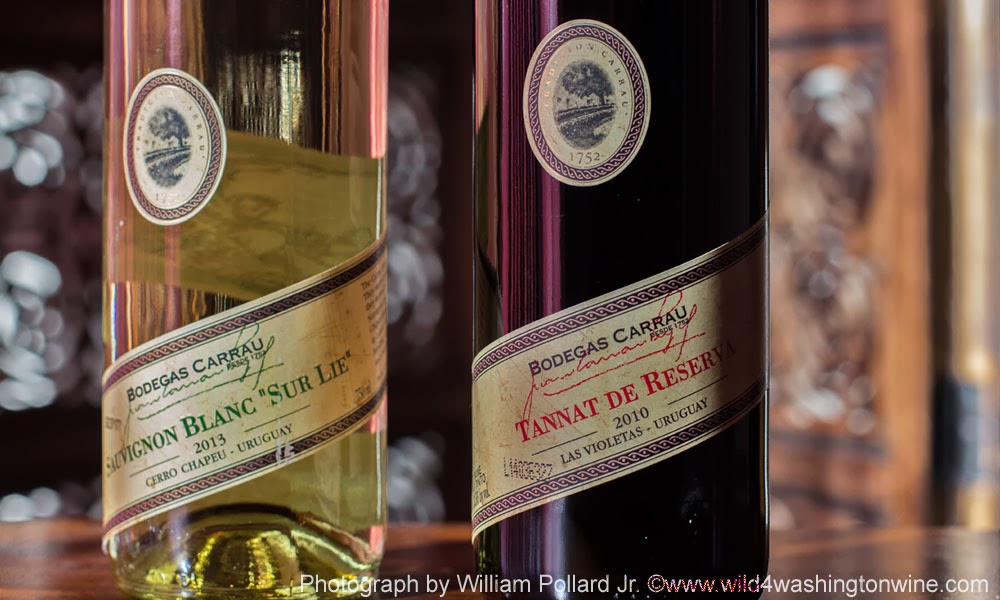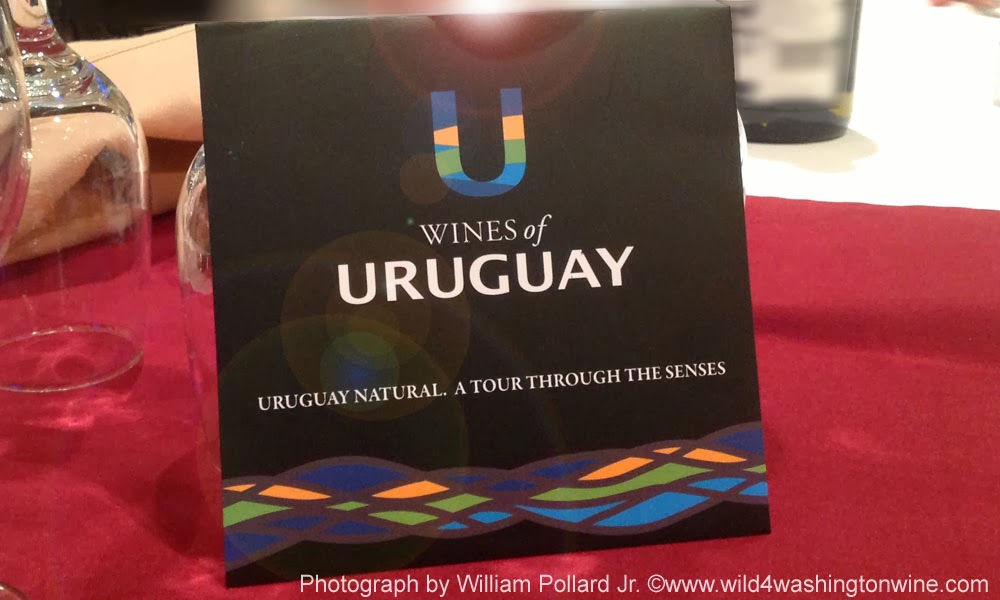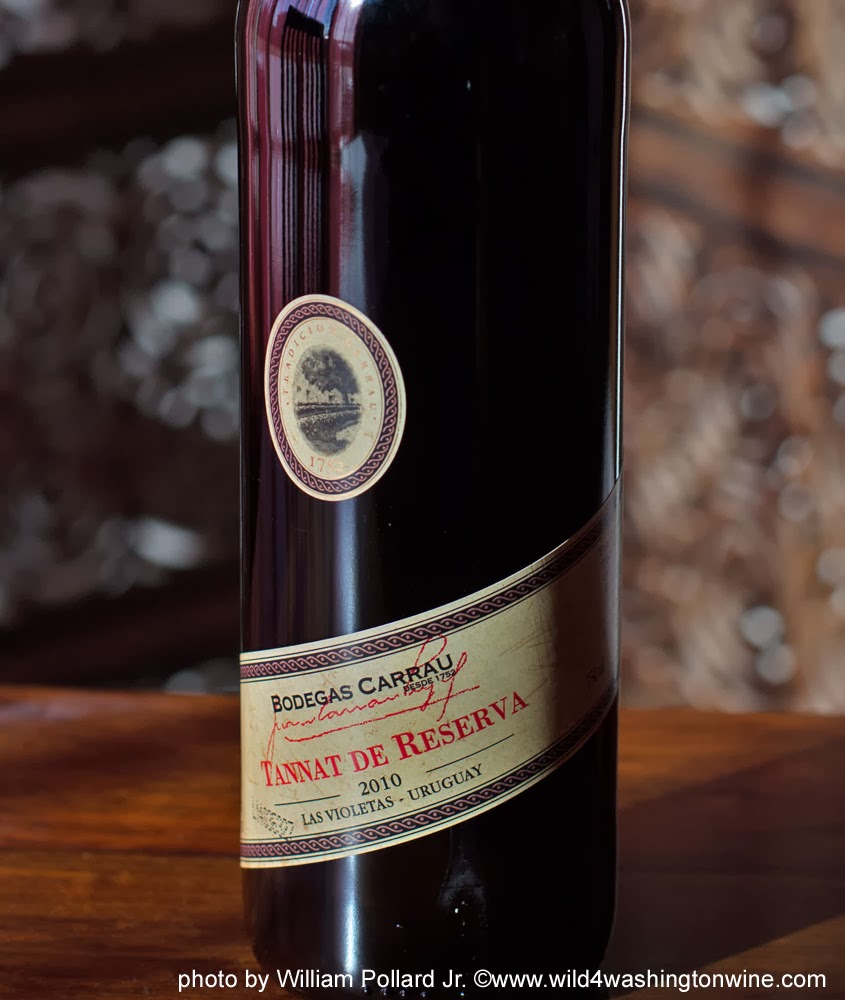Last year I attended a presentation by Professor Francisco Carrau at a luncheon on the Wines of Uruguay. It was my first opportunity to experience wines produced in this smallest South American country. The wines were impressive. My attention was especially captivated by the red wines. I was thoroughly intrigued by the Tannat. Later, I had a chance to sample more Tannat from Uruguay and to visit briefly with Mr. Francisco Carrau, winemaker of Bodegas Carrau. Wow! They had my attention.
In Uruguay red wine means Tannat. Tannat is a hardy varietal from France, originally made for kings, it is now the national red grape variety of Uruguay. Call me excited when I had the opportunity to participate in a Virtual Wine Tasting of wines from Uruguay. Wines made by the Carrau family!
 |
| Bodegas Carrau Sauvignon Blanc and Tannat Reserva. |
It was a pleasure this week to taste and tweet about the Bodegas Carrau 2013 Sauvignon Blanc "Sur Lie" and the Bodegas Carrau 2010 Tannat De Reserva. I would like to thank Our World, Our Community for allowing me to participate in this wonderful wine tasting. You can consider me a fan of wines from Uruguay, and Bodegas Carrau. I'm eager to drink more Tannat.
About Bodegas Carrau
The first Carrau family member involved in winemaking was Francisco Carrau Vehils, a fisherman who started the original family winery in Catalunya, Spain in 1752. Today, the eighth generation of Carrau winemakers continue with passion in Uruguay. The Carrau family has been making wine for 260 years.
 |
| Winemaker Francisco Carrau speaking about wines of Uruguay. |
Winemakers Francisco Carrau and Octavio Gioianacio practice sustainable farming techniques in the vineyard. They have two vineyards, one in Cerro Chapeau in northeast Uruguay and another in Las Violetas in southern Uruguay. They emphasize the fruit, not the oak. They are producing beautiful wines.
Tasting Notes 2013 Sauvignon Blanc "Sur Lie"
FYI: Fermented and left for six months in contact with the lies (Sur Lie).
Color: Pale silver-gold with hint of green.
Nose: Citrus, mineral, passion fruit, toasted coconut.
Palate: Crisp citrus, grapefruit, passion fruit, white peach, tea, good mouth feel, round,
fruity, long finish.
Day 2: Jasmin tea stood out on the finish. Still fresh with zesty grapefruit and soft pineapple, but enhanced by floral tea. It was just as good on day three. Terrific value at $14. Highly Recommended.
Blend: 100% Sauvignon Blanc, hand harvested
Country: Uruguay
Region: Cerro Chapeau, northern Uruguay
SRP: $14
ABV: 13.5%
Closure: Aglomerated cork
Production: 2,250 cases
Sample provided by Our World, Our Community, San Diego, CA
Tasting Notes 2010 Tannat De Reserva
FYI: Tannat is known for having the highest concentrations of oligomeric procyanidins (OPCs), an anti-oxidant which helps repair cells and thin blood - which is associated with health benefits and longer life spans. Some intriguing research is ongoing into the benefits of Tannat on health.
Color: Garnet.
Nose: At first restrained, whiff of blueberry and pepper, then leather, blackberry,
incense, sandalwood.
Palate: Fluid, instant like, filled the mouth, plum, some friendly acid back palate, plum,
orange peel on the medium dry finish. A lot of pleasure in the bottle. A less aggressive representation of Tannat, which can be rather big and bold.
Day 2 it was very focused. Not soft, not over the top, just a pure pleasure to drink. Fantastic value at $14 and a wonderful introduction to Tannat. Highly recommended.
Blend: 100% Tannat, hand harvested
Country: Uruguay
Region: Las Violetas, southern Uruguay
Fermented in stainless with native yeasts
SRP: $14
ABV: 13.5%
Closure: agglomerated cork
Production: 5,000 cases
Sample provided by Our World, Our Community, San Diego, CA
 |
| Tannat and OPC concentration. |
- Tannat - also known as: Bordelez Beltza, Harriague, Madiran, Moustrou, Moustron and Tanat.
- Tannat is known for having the highest concentrations of oligomeric procyanidins (OPCs), an anti-oxidant which helps repair cells and thin blood - which is associated with health benefits and longer life spans.
- Tannat is quite tannic -due in part to the berries’ thick skins.
- Tannat is one of the easiest varietals to grow. It is frost hardy and a solid producer whether trellised or head-pruned.
- The oldest Tannat vines are found in Uruguay at 100 years old. Older than the vines in France.
- Though many scholars believe Tannat originated in the Basque region of France, Tannat is most closely associated with the winemaking region of Madiran, at the foothills of the Pyrenees Mountains in southwest France.
- The grape has been grown in that region for centuries, and 17th and 18th century French kings accepted Madiran wines as payment for taxes.
- Tannat continues to be grown in the Basque country, most notably in the tiny appellation of Iroulèguy, on the Spanish border.
- In 1870, Basque immigrants brought the grape to Uruguay, where it adapted perfectly to the local soil and climate. It has since become the national red grape variety of Uruguay, accounting for approximately one third of all wine produced in that country.
- More Tannat is grown in Uruguay than in the varietal’s native France.
- Tannat is also in Brazil, Italy, British Columbia, Peru, Australia, Switzerland, South Africa & Japan.
- Uruguay: "River of Birds" in the native aboriginal language.
- Uruguay has 450 species of birds in the smallest country of South America.
- Uruguay has 3rd purest vineyard environment according to Yale and Columbia Universities.
- There are 3,500 growers, 270 wineries, 22000 acres of vines, and 10 million cases of wine produced annually.
- In the 1870s, Basque settlers brought Madiran (Tannat) with them to Uruguay.
- 22% of the vineyards in Uruguay are Tannat
- More cattle and sheep than people, similar in size to New Zealand.
- Uruguay exports only 5% of the wine produced. Because they drink a lot of the wine.
I encourage you seek out wines from Uruguay and especially wines made by Bodegas Carrau. Read up on the health benefits of Tannat too.
Cheers!


